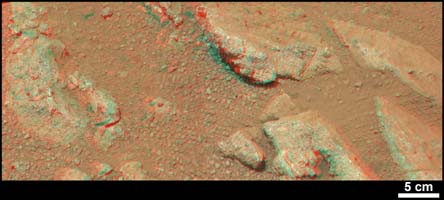
Figure 1
Click on the image for larger versionThis stereo view from NASA's Mars rover Curiosity shows a rock called "Link," which bears rounded pebbles that provide evidence about vigorous flow of water in a stream on ancient Mars. The scene appears three dimensional when viewed through red-blue glasses with the red lens on the left. The scale bar at lower right is 5 centimeters (2 inches).
Link contains rounded gravel fragments, or clasts, up to a couple inches (few centimeters) in size, in a matrix of white material. Many gravel-sized rocks have eroded out of the outcrop onto the surface, particularly in the left portion of the frame. Water transport is the only process capable of producing the rounded shape of clasts of this size.
Curiosity's Mast Camera instrument (Mastcam) acquired component images of this scene on the 27th Martian day, or sol, of the mission (Sept. 2, 2012). The Mastcam has two cameras, a telephoto right eye (Mastcam 100) with a 100-millimeter-focal-length lens, and a moderately wide-angle left eye (Mastcam 34) with a 34-millimeter lens. This stereo image combines images from each eye.
The name Link is derived from a significant rock formation in the Northwest Territories of Canada, where there is also a lake with the same name.
Scientists enhanced the color in this version to show the Martian scene as it would appear under the lighting conditions we have on Earth, which helps in analyzing the terrain. A version closer to the raw color recorded by the camera on Mars (adjusted for stereo effect) is available as Figure 1.
Malin Space Science Systems, San Diego, built and operates Mastcam. NASA's Jet Propulsion Laboratory manages the Mars Science Laboratory mission and the mission's Curiosity rover for NASA's Science Mission Directorate in Washington. The rover was designed, developed and assembled at JPL, a division of the California Institute of Technology in Pasadena.
For more about NASA's Curiosity mission, visit http://www.jpl.nasa.gov/msl, http://www.nasa.gov/mars, and http://marsprogram.jpl.nasa.gov/msl.

